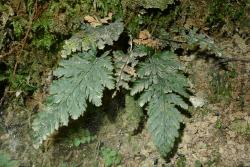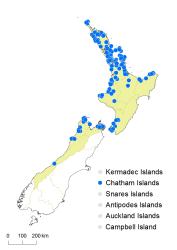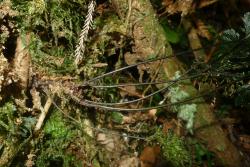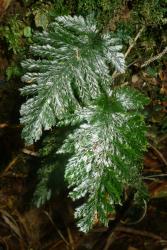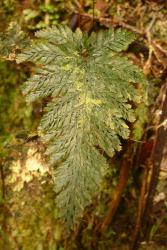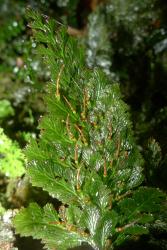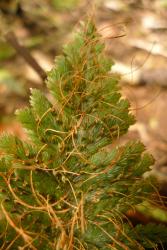- ≡ Trichomanes rigidum var. elongatum (A.Cunn.) Hook. & Baker, Syn. Fil. [Hooker & Baker] 86 (1867)
- ≡ Selenodesmium elongatum (A.Cunn.) Copel., Philipp. J. Sci. 67: 82 (1938)
- ≡ Abrodictyum elongatum (A.Cunn.) Ebihara & K.Iwats. in Ebihara et al., Blumea 51: 244 (2006)
- = Trichomanes polyodon Colenso, Trans. & Proc. New Zealand Inst. 28: 618 (1896)
Terrestrial or rupestral ferns. Rhizomes erect or short-creeping, bearing dark brown hairs 1–5 mm long. Fronds 95–360 mm long, held at an angle or horizonatally. Stipes 30–250 mm long, brown, glabrous or hairy proximally, not winged. Laminae 1–2-pinnate distally to 2–3-pinnate proximally, ovate or triangular, 48–140 mm long, 26–100 mm wide, dark olive-green, herbaceous, glabrous or with very short scattered hairs along veins. Rachises not winged or winged only near the lamina apices, brown or dark green, glabrous or occasionally hairy. Primary pinnae in 10–20 pairs, overlapping, narrowly winged in distal half, stalked; distal primary pinnae elliptic or narrowly ovate; proximal primary pinnae ovate; the longest primary pinnae at or near the base, 17–60 mm long, 7–26 mm wide. Secondary pinnae overlapping, winged in distal half, more or less stalked; narrowly elliptic or narrowly obovate on distal primary pinnae, narrowly elliptic or narrowly ovate or ovate on proximal primary pinnae; the longest secondary pinnae 7–18 mm long, 3–6 mm wide. Longest tertiary pinnae obovate or elliptic, deeply divided at apices, 4–10 mm long, 1.2–3.2 mm wide, adnate to decurrent, the veins forking several times in each; apices acute or obtuse; margins entire, lacking a border. Sori borne acroscopically and basiscopically in notches of ultimate segments at base of secondary pinnae close to costae of primary pinnae, several on each primary pinna, sessile or shortly stalked; indusia tubular, c. 2 mm long, scarcely widened at mouth; sporangia borne on a stout receptacle up to 25 mm long, projecting far beyond the indusia at maturity.
Trichomanes elongatum is recognised by its erect rhizome, ovate or triangular dark olive-green laminae, lack of a wing on most of the rachis, broad and overlapping lamina segments with the veins forking several times in each, and conspicuous brown receptacles far-exserted beyond the indusial flaps. The laminae are often covered in epiphyllous mosses and liverworts.
North Island: Northland, Auckland, Volcanic Plateau, Gisborne, Taranaki, Southern North Island.
South Island: Western Nelson, Sounds Nelson, Westland.
Chatham Islands.
Altitudinal range: 10–700 m.
In the North Island Trichomanes elongatum occurs throughout Northland and Auckland, extending eastwards through the Bay of Plenty to East Cape, and down the west coast as far as Wellington. It is found in coastal and lowland forest, reaching 560 m in Kaihu Forest, Northland and 700 m on the summit of Little Barrier Island. In the South Island it is confined to coastal and lowland areas of the Marlborough Sounds and north-west Nelson below 90 m, with an outlying population at Lake Matheson, Westland. It is known from a single collection on the Chatham Islands (AK 300691).
Occurs on the ground, amongst roots, on banks and rocks, under overhangs and beside streams in dark, damp kauri, podocarp and broadleaved forest and in old mānuka and kānuka scrub.
In the classification of Ebihara et al. (2006), Trichomanes elongatum is treated as Abrodictyum elongatum.
Trichomanes elongatum was described by Cunningham (1837) citing a specimen from "Dark ravines in the forests of Wangaroa, etc. – 1834, R. Cunningham". Allan (1961) stated "Type: R. Cunningham, 1834, BM". However, the only specimens in BM from Cunningham’s herbarium are labelled "Bay of Islands, New Zealand, May 1838" and "New Zealand, A. Cunningham". Both of these are in conflict with the protologue, and hence Allan’s statement cannot be regarded as a lectotypification. Nevertheless, there is a specimen at K from Cunningham’s herbarium which is labelled "In damp woods of Wangaroa & Hokianga, R. Cunningham, 1834". This specimen is the holotype (Brownsey & Perrie 2016).
Croxall (1975) considered that Trichomanes elongatum (as Selenodesmium elongatum) occurred in Queensland and New South Wales, although he conceded that the distinctions between it and S. dentatum (widespread in the Pacific) and S. obscurum (from Asia, Australia and the western Pacific) were far from clear. Bostock & Spokes (1998) recognised only the latter species in Australia (as Cephalomanes obscurum), leaving Trichomanes elongatum as endemic to New Zealand. Nevertheless, the relationships between these three species are close and worthy of further investigation.



